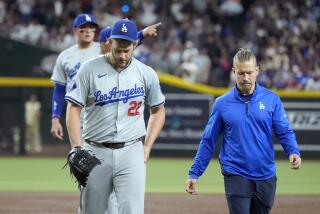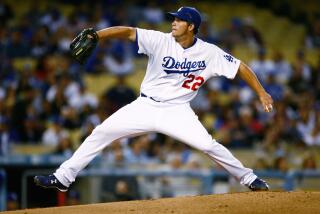BASEBALL / ROSS NEWHAN : Eckersley Not Ready for Relief
The scouting report on rookie Steve Chitren as offered by pitching coach Dave Duncan of the Oakland Athletics: Good fastball, great curve, composure beyond his 23 years.
The A’s are so high on the Stanford biology graduate, their sixth-round selection in the 1989 June draft, that he already carries a burden of great expectations.
He is being called “the next Eckersley,” though no one has put a time frame on it. No one dares, because the real Dennis Eckersley shows no signs of fatigue, no deterioration in his ability or incredible control.
At 36, he has opened the new season much as he has the last three, his performances so consistent, so close to flawless that they are almost taken for granted.
But not by Eckersley.
“If people are honest, they admit to doubts,” he said. “I have them every time I go to the mound, and it helps to keep me sharp. I mean, I’m proud of what I’ve accomplished, but I’m not done. It’s not time to gloat. The trial never ends. I feel like I always have to prove myself, which means I never want to reach the point of total satisfaction.”
Jose Canseco may get an average annual salary of $4.7 million, and Rickey Henderson can point to the plaque he was given as the American League’s most valuable player, but make no mistake: Eckersley is the foundation of the A’s success, the player they can least afford to lose.
He has proved it again during their injury wave of the first two weeks. He was four for four in saves through Thursday, having given up two hits in six innings while not allowing a run or a walk.
So, what’s new? While Bobby Thigpen of the Chicago White Sox received the publicity with his record 57 saves last year, Eckersley converted 48 of 50 save opportunities and had a 0.61 earned-run average, the lowest in history, even if the qualifying standard is as few as 25 innings, according to the Elias Baseball Analyst.
He walked only seven batters in 131 innings of the 1989 and 1990 seasons for ratios of one every 19.2 batters and 18.3, the two best in history for pitchers working a minimum of 50 innings, according to the Elias book.
And last year, he did not issue a walk until June 12, snapping a two-year streak of 185 batters.
Eckersley shook his head the other day and said, “You can get carried away with the business of not walking anyone to the extent that you begin to pitch stupidly. Sometimes, you should walk a batter. It’s the right move.
“I walked Kent Hrbek on four pitches with a base open last year and felt good about it because it would have been dumb to give him a pitch to pull.
“I mean, I’d just as soon get (the first walk) over with. It was the only thing people were talking about last year and I was happy to finally get (a mid-summer walk to Julio Franco) behind me.”
There is more to talk about where Eckersley is concerned, of course. He has converted 126 of 143 save opportunities in his three seasons as a full-time reliever, weathering the traumatic home run by Kirk Gibson in Game 1 of the 1988 World Series with the Dodgers to register 81 saves in the last two years. He is one of only three relievers--Jeff Reardon and Dan Quisenberry being the others--to save 40 or more games twice and could become the first to do it three times.
“I’ve got to believe he’s as good as anyone who has ever done what he does,” Duncan said. “And if you’re talking only about his control, how could you be better? It’s not just the few walks, it’s putting almost every pitch where he wants it.”
Blessed with depth, the A’s have contributed to Eckersley’s success by using him judiciously, or as he put it, delicately. He made a career-high 63 appearances last year but totalled only 73 1/3 innings. He has made 174 appearances spanning 203 2/3 innings over the last three years. Thigpen, 27, who has one fewer save in that period, has pitched 257 innings in 206 appearances.
“He’s got a young arm and I’ve got an old arm,” Eckersley said. “He can make 70 (appearances) a year, but 60 is about it for me. I mean, I don’t think I would have had this success pitching anywhere else. I’d have been blown out or less effective.”
Eckersley added that he now carries the “extra incentive” of trying to prove to the cynics who cite only his age that he can maintain his durability and effectiveness 18 years after throwing his first professional pitch. In those 18 years he has won 20 games in a season for the Boston Red Sox, pitched a no-hitter for the Cleveland Indians, won 10 or more games as a starter nine times, fought and overcame alcoholism and adjusted to his new role when he was serving only as a spot starter, his future in doubt.
Tony La Russa, the A’s manager, said that Eckersley could remain the closer for several more years.
“I reached the point in ’88 (Eckersley’s first full year as the closer) that I recognized we had a special talent,” La Russa said. “I’m not surprised by it anymore. I just admire it and use it.
“Our goal is to get Eck out there at 100% as often as we can. We’re trying to do what’s best for Eck and the A’s, but we don’t use him with the idea of getting three or four more years out of him. When we look around a corner it’s only to tomorrow’s game.”
And not yet to the next Eckersley.
RICKEY’S RETURN
Eventually, Rickey Henderson will return to the A’s lineup and break Lou Brock’s record of 938 stolen bases. He needs two more.
The record, though, will be only a milestone on his way to new heights.
“If I can stay away from serious injuries I still think I can steal 1,500,” Henderson said in Anaheim the other day, still sidelined by a strained calf muscle.
He is 32 and has averaged 78 steals over the last three years. If he has 1,000 at the end of the 1991 season and maintains that average, he will need about 6 1/2 seasons to reach 1,500.
But the latest injury, he said, merely confirms his suspicion that he will eventually have to slow his pace. In fact, his ultimate goal would be to go through a season without any steals.
“Some year I’d love to forget the base stealing and just go out and hit,” he said. “I’d love to let my knees and my hands and my shoulders have a year off. I’d probably hit .330 or .340 with 30 or 35 home runs, but then Rickey Henderson is expected to steal, and I expect it of myself. It would be hard to shut down.”
NO, MAAS
Kevin Maas, who made his mark as the New York Yankees’ designated hitter last year with 21 homers in 79 games, is paying a price.
No pitcher wants any part of him, and it is likely to continue unless the Yankees who hit ahead of and behind him get on base regularly.
Maas was batting .333 with two home runs and eight runs batted in through nine games but had drawn 15 walks, projecting to 301 for the season. Babe Ruth walked 170 times in 1923, the major league record.
Said Detroit Tiger Manager Sparky Anderson after his pitchers had walked Maas six times in a three-game series:
“The guy hitting behind Maas, whether it’s (Hensley) Meulens or (Mel) Hall or (Jesse) Barfield will have to come through because no one is going to pitch to a kid with that kind of swing in a tough situation, especially at Yankee Stadium (with it’s short porch in right field).”
Yankee batting coach Frank Howard, believing a walk is as good as a hit, wants Maas to maintain his patience and discipline, but the Chicago White Sox tested him again last week by pitching cautiously and overloading the right side with three infielders. Maas responded with a key bunt down the third base line in Wednesday’s 10-1 win.
“You don’t have to be too smart to see what they’re doing,” said Maas, who is smart enough. He has a mechanical engineering degree from UC Berkeley.
CHANGING THEIR TUNE
In spring training, when the Cincinnati Reds talked about the vast changes in the National League West, they said such changes were necessary if the other teams were going to beat the Reds, who didn’t need to change to repeat as league and World Series champions.
But now, after starting sluggishly, compared to their April bolt of last year, the Reds are voicing signs of unrest.
“We stood a little too pat, if you ask me,” reliever Rob Dibble said. “Everybody did something but us, but then we have such conservative management. We had a chance to get Bobby Bonilla (from Pittsburgh), but I know there’s no way Marge (Schott, the owner) is going to spend $22 million to get Bonilla, or anyone else.
“If we added just a couple of guys, we’d be winning year after year, just like Oakland. I mean, we’re that good.”
Added Jose Rijo, feigning anger at failing to win the California lottery while in San Diego this week: “I kept telling everyone that if I won the lottery I’d buy this team, then go out and buy a power hitter and a starting pitcher so we can put (Norm) Charlton back in the bullpen. Then we’ll be ready to repeat.”
More to Read
Go beyond the scoreboard
Get the latest on L.A.'s teams in the daily Sports Report newsletter.
You may occasionally receive promotional content from the Los Angeles Times.










